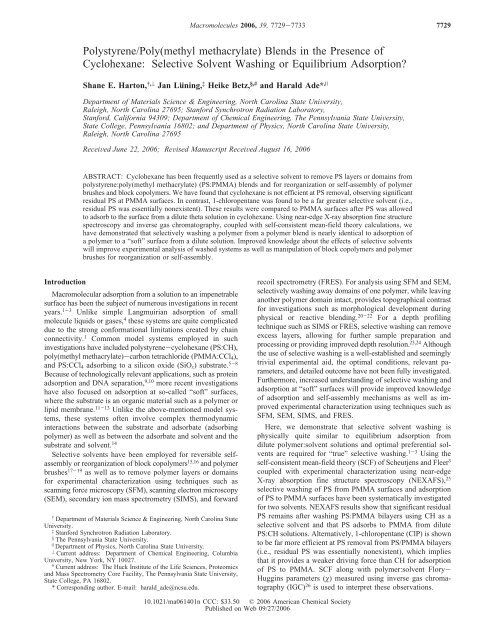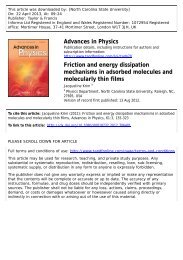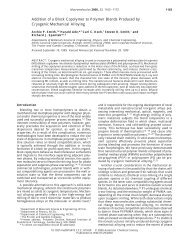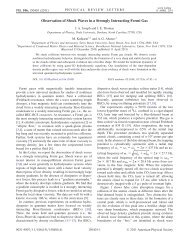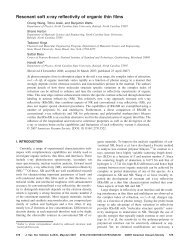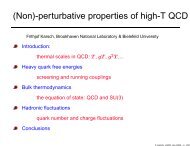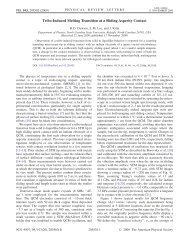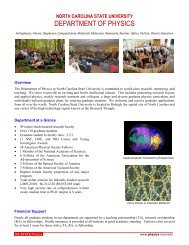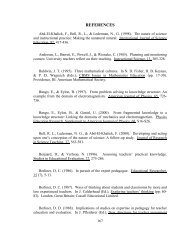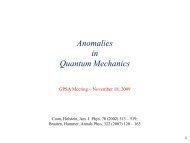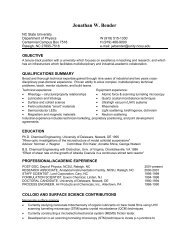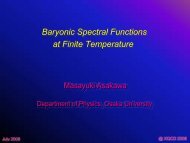Polystyrene/Poly(methyl methacrylate) - Physics - North Carolina ...
Polystyrene/Poly(methyl methacrylate) - Physics - North Carolina ...
Polystyrene/Poly(methyl methacrylate) - Physics - North Carolina ...
Create successful ePaper yourself
Turn your PDF publications into a flip-book with our unique Google optimized e-Paper software.
Macromolecules 2006, 39, 7729-77337729<strong><strong>Poly</strong>styrene</strong>/<strong>Poly</strong>(<strong>methyl</strong> <strong>methacrylate</strong>) Blends in the Presence ofCyclohexane: Selective Solvent Washing or Equilibrium Adsorption?Shane E. Harton, †,⊥ Jan Lu1ning, ‡ Heike Betz, §,# and Harald Ade* ,|Department of Materials Science & Engineering, <strong>North</strong> <strong>Carolina</strong> State UniVersity,Raleigh, <strong>North</strong> <strong>Carolina</strong> 27695; Stanford Synchrotron Radiation Laboratory,Stanford, California 94309; Department of Chemical Engineering, The PennsylVania State UniVersity,State College, PennsylVania 16802; and Department of <strong>Physics</strong>, <strong>North</strong> <strong>Carolina</strong> State UniVersity,Raleigh, <strong>North</strong> <strong>Carolina</strong> 27695ReceiVed June 22, 2006; ReVised Manuscript ReceiVed August 16, 2006ABSTRACT: Cyclohexane has been frequently used as a selective solvent to remove PS layers or domains frompolystyrene:poly(<strong>methyl</strong> <strong>methacrylate</strong>) (PS:PMMA) blends and for reorganization or self-assembly of polymerbrushes and block copolymers. We have found that cyclohexane is not efficient at PS removal, observing significantresidual PS at PMMA surfaces. In contrast, 1-chloropentane was found to be a far greater selective solvent (i.e.,residual PS was essentially nonexistent). These results were compared to PMMA surfaces after PS was allowedto adsorb to the surface from a dilute theta solution in cyclohexane. Using near-edge X-ray absorption fine structurespectroscopy and inverse gas chromatography, coupled with self-consistent mean-field theory calculations, wehave demonstrated that selectively washing a polymer from a polymer blend is nearly identical to adsorption ofa polymer to a “soft” surface from a dilute solution. Improved knowledge about the effects of selective solventswill improve experimental analysis of washed systems as well as manipulation of block copolymers and polymerbrushes for reorganization or self-assembly.IntroductionMacromolecular adsorption from a solution to an impenetrablesurface has been the subject of numerous investigations in recentyears. 1-3 Unlike simple Langmuirian adsorption of smallmolecule liquids or gases, 4 these systems are quite complicateddue to the strong conformational limitations created by chainconnectivity. 1 Common model systems employed in suchinvestigations have included polystyrene-cyclohexane (PS:CH),poly(<strong>methyl</strong> <strong>methacrylate</strong>)-carbon tetrachloride (PMMA:CCl 4 ),and PS:CCl 4 adsorbing to a silicon oxide (SiO x ) substrate. 5-8Because of technologically relevant applications, such as proteinadsorption and DNA separation, 9,10 more recent investigationshave also focused on adsorption at so-called “soft” surfaces,where the substrate is an organic material such as a polymer orlipid membrane. 11-13 Unlike the above-mentioned model systems,these systems often involve complex thermodynamicinteractions between the substrate and adsorbate (adsorbingpolymer) as well as between the adsorbate and solvent and thesubstrate and solvent. 14Selective solvents have been employed for reversible selfassemblyor reorganization of block copolymers 15,16 and polymerbrushes 17-19 as well as to remove polymer layers or domainsfor experimental characterization using techniques such asscanning force microscopy (SFM), scanning electron microscopy(SEM), secondary ion mass spectrometry (SIMS), and forward† Department of Materials Science & Engineering, <strong>North</strong> <strong>Carolina</strong> StateUniversity.‡ Stanford Synchrotron Radiation Laboratory.§ The Pennsylvania State University.| Department of <strong>Physics</strong>, <strong>North</strong> <strong>Carolina</strong> State University.⊥ Current address: Department of Chemical Engineering, ColumbiaUniversity, New York, NY 10027.# Current address: The Huck Institute of the Life Sciences, Proteomicsand Mass Spectrometry Core Facility, The Pennsylvania State University,State College, PA 16802.* Corresponding author. E-mail: harald_ade@ncsu.edu.recoil spectrometry (FRES). For analysis using SFM and SEM,selectively washing away domains of one polymer, while leavinganother polymer domain intact, provides topographical contrastfor investigations such as morphological development duringphysical or reactive blending. 20-22 For a depth profilingtechnique such as SIMS or FRES, selective washing can removeexcess layers, allowing for further sample preparation andprocessing or providing improved depth resolution. 23,24 Althoughthe use of selective washing is a well-established and seeminglytrivial experimental aid, the optimal conditions, relevant parameters,and detailed outcome have not been fully investigated.Furthermore, increased understanding of selective washing andadsorption at “soft” surfaces will provide improved knowledgeof adsorption and self-assembly mechanisms as well as improvedexperimental characterization using techniques such asSFM, SEM, SIMS, and FRES.Here, we demonstrate that selective solvent washing isphysically quite similar to equilibrium adsorption fromdilute polymer:solvent solutions and optimal preferential solventsare required for “true” selective washing. 1-3 Using theself-consistent mean-field theory (SCF) of Scheutjens and Fleer 3coupled with experimental characterization using near-edgeX-ray absorption fine structure spectroscopy (NEXAFS), 25selective washing of PS from PMMA surfaces and adsorptionof PS to PMMA surfaces have been systematically investigatedfor two solvents. NEXAFS results show that significant residualPS remains after washing PS:PMMA bilayers using CH as aselective solvent and that PS adsorbs to PMMA from dilutePS:CH solutions. Alternatively, 1-chloropentane (ClP) is shownto be far more efficient at PS removal from PS/PMMA bilayers(i.e., residual PS was essentially nonexistent), which impliesthat it provides a weaker driving force than CH for adsorptionof PS to PMMA. SCF along with polymer:solvent Flory-Huggins parameters (χ) measured using inverse gas chromatography(IGC) 26 is used to interpret these observations.10.1021/ma061401n CCC: $33.50 © 2006 American Chemical SocietyPublished on Web 09/27/2006
7730 Harton et al. Macromolecules, Vol. 39, No. 22, 2006Table 1. <strong>Poly</strong>mers Used in This Investigationpolymer supplier M n/kDa M w/M nPS-8 SPP 8.0 1.05PS-10 PL 10.1 1.02PS-12 SPP 12.4 1.06PS-18 SPP 18.1 1.07PS-29 SPP 29.1 1.09PS-107 SPP 107 1.08PMMA-92 SPP 92.5 1.09PMMA-808 SPP 808 1.04Experimental SectionFor this investigation, we selected PS and PMMA, as they are ahighly investigated polymer pair 15-19,21 and are completely immisciblefor all molecular weights used here. 27,28 Monodisperseatactic PS (T g ≈ 100 °C) and syndiotactic PMMA (T g ≈ 130 °C)spanning a range of molecular weights were purchased fromScientific <strong>Poly</strong>mer Products (SPP) or <strong>Poly</strong>mer Laboratories (PL),and their properties are summarized in Table 1. Silicon (100) waferswere cut into 2.5 cm × 2.5 cm squares and cleaned followingestablished procedures. 29 First, they were soaked in a solution ofsulfuric acid/hydrogen peroxide for 30 min at ∼100 °C to removesurface contaminants. Next, they were rinsed with deionized (DI)water. To remove the ∼2 nm oxide layer (SiO x ) created duringthis process, the substrates were soaked in hydrofluoric acid (10%v/v) for 1 min and again rinsed with DI water to leave a hydrogenpassivatedsurface (SiH). Cyclohexane (Acros) was distilled overcalcium hydride immediately prior to use, 1-chloropentane (Aldrich)was stored over 4 Å molecular sieves (Acros), and chlorobenzene(Sigma-Aldrich) was used as received. PMMA-92 and PMMA-808 were each dissolved in chlorobenzene and subsequently filteredwith 0.45 µm PTFE syringe filters. They were then cast onto theSiH surfaces to a thickness of ∼150 nm and annealed at 165 °Cfor 12 h to provide smooth, uniform PMMA substrates.For the investigation of selective washing of PS from PMMA,PS-10 and PS-107 were cast from ClP (thickness ∼ 100 nm) ontoPMMA-92 and annealed at 150 °C for 1 h. The bilayer assemblieswere washed with ClP (samples A and B) or CH (samples C andD) at room temperature (25 °C). Washing involves immersing thesample into pure solvent (CH or ClP), manually agitating thesolution with the immersed sample, and then drying with an N 2jet. This process is repeated 4-5 times for each sample (samplesA-D). Similarly, PS-18 was cast onto PMMA-808 from CH(thickness ∼ 200 nm) and either immediately soaked in pureanhydrous CH for 5 min followed by a CH rinse (sample E) orannealed for 12 h at 120 °C to form an equilibrium interface 30,31and then soaked in pure anhydrous CH for 5 min followed by aCH rinse (sample F). The diffusion constant (D) for 130 kDa PSin dilute CH solutions at 34.5 °C has been reported to be ∼3 ×10 -7 cm 2 /s, 32 which would provide D ≈ 8 × 10 -7 cm 2 /s for PS-18in solution (D ∼ M w-1/2for a dilute theta solution 32,33 ). Therefore,a 5 min immersion time will allow the unadsorbed PS-18 chainsto move ∼ (2Dt) 1/2 ∼ 600R g (radii of gyration) from the surface(considering the diffusive flux only), while the adsorbed chainswill remain at the surface. 34,35For the investigation of PS adsorption to PMMA, PS powderwas placed in 120 mL amber jars and annealed under vacuum at120 °C for 12 h to remove any residual solvents that may interferewith the adsorption process (e.g., methanol is often used toprecipitate PS after polymerization). The PS used here (see Table1) had been synthesized using living anionic polymerization 36 andhad no functional groups added along the chains or chain ends.Anhydrous CH was added to the annealed PS powder to create0.1% (v/v) solutions of PS-8 (sample G), PS-12 (sample H), PS-18 (sample I), or PS-29 (sample J). PMMA-808 substrates wereimmersed completely in the solution, and the amber jars were closedand sealed with Teflon tape. The jars were placed in an ethyleneglycol bath maintained at 34.5 ( 0.5 °C (theta temperature for PS/CH) 37 for 24 h. Upon removal from the adsorption solutions, thesubstrates were immediately rinsed with anhydrous cyclohexaneto remove any unadsorbed PS chains, blown dry with N 2 , andsubsequently placed under vacuum at 25 °C for 1 h. Table 2summarizes these sample preparation steps.Samples A-J and pure reference (PS-107 and PMMA-92) filmswere analyzed using NEXAFS spectroscopy 25 at beamline 10-1 ofthe Stanford Synchrotron Radiation Laboratory (SSRL). Carbon1s NEXAFS spectra (∼280 eV) 38 were recorded by monitoring thetotal electron yield (TEY), which has an effective 1/e samplingdepth (λ 0 ) of ≈3-4 nm (i.e., ≈63% of the spectral intensityoriginates from the outermost 3-4 nm of the film). 39 At least threespots were analyzed on each sample, with at least two samples foreach sample type. All spectra were recorded with an energyresolution of E/∆E > 5000 and in the so-called magic anglegeometry, which suppresses polarization dependencies. 25Inverse gas chromatography 26 was used to characterize the phasebehavior of 1-chloropentane with PMMA and PS, within theconcentration limit of pure polymer, at temperatures of 150, 160,and 170 °C. Experiments were conducted at the Center for the Studyof <strong>Poly</strong>mer-Solvent Systems (The Pennsylvania State University)with a commercially available gas chromatograph using capillarycolumns coated with atactic PMMA (M w ∼ 996 kDa) (1193.7 cm× 3.0 µm × 0.053 cm i.d.) and with atactic PS (M w ∼ 200 kDa)(844.5 cm × 5.0 mm × 0.053 cm i.d.). 1-Chloropentane wasinjected as a sharp spike into the columns. The resulting elutionprofiles were fitted and regressed for the partition coefficient (K)using the capillary column inverse gas chromatography (CCIGC)model. 26 The Flory-Huggins interaction parameters, in the limitof pure polymer (χ ∞ ), were then calculated using the measuredvalues for K.Results and DiscussionCarbon K-edge NEXAFS spectra of samples A-D are plottedin Figure 1. Also shown in the figure inset are the referencespectra of PMMA and PS. The obvious difference between thesetwo spectra is that the PS spectrum exhibits a sharp C 1s fπ* CdC resonance at 285.18 eV (transition of the 1 s core levelto the lowest unoccupied molecular orbital of the phenyl ring)while the strongest resonance of the PMMA spectrum is locatedat 288.52 eV and is aC1sf π* CdO resonance transition tothe lowest unoccupied molecular orbital of the ester group. 38Comparison of these reference spectra to the NEXAFS spectraof samples A-D shows that the concentration of residual PSat the PMMA surface is a strong function of the PS molecularweight and the solvent type used for washing. For example,Table 2. Systems and Preparation Methodssample PMMA PS process 1 process 2 process 3A PMMA-92 PS-10 spin cast (ClP) anneal (150 °C) ClP rinseB PMMA-92 PS-107 spin cast (ClP) anneal (150 °C) ClP rinseC PMMA-92 PS-10 spin cast (ClP) anneal (150 °C) CH rinseD PMMA-92 PS-107 spin cast (ClP) anneal (150 °C) CH rinseE PMMA-808 PS-18 spin cast (CH) CH soakF PMMA-808 PS-18 spin cast (CH) anneal (120 °C) CH soakG PMMA-808 PS-8 adsorb (CH) CH rinseH PMMA-808 PS-12 adsorb (CH) CH rinseI PMMA-808 PS-18 adsorb (CH) CH rinseJ PMMA-808 PS-29 adsorb (CH) CH rinse
Macromolecules, Vol. 39, No. 22, 2006 PS:PMMA Blends in Presence of Cyclohexane 7731Figure 1. NEXAFS results for samples A-D. Considerable PS isobserved when CH was used to wash the sample, particularly for sampleD (PS-107), where complete saturation of the PMMA surface isobserved.Figure 3. NEXAFS results in the π* region (285.18 eV) for samplesE, F, and I. Here, it is shown that adsorption of PS to the PMMAsurface from a CH solution (sample I) is almost identical to washinga PS/PMMA bilayer with CH after an equilibrium interface has beenformed by annealing at 120 °C for 12 h (sample F). However, if thePS/PMMA bilayer is washed with CH without annealing to form anequilibrium interface, much less residual PS is observed (sample E).Figure 2. IGC measurements of χ ∞ for (O) PS:ClP and (∆) PMMA:ClP (150-170 °C), along with previously reported results (ref 40) for(b) PS:CH (160-180 °C) and (- - -) PMA:CH (90-110 °C). Linesare linear fits to the experimental data. Results for PMA:CH wereextrapolated to a temperature range of ≈150-180 °C for comparisonto the other polymer:solvent systems.for sample D (PS-107 washed with CH), there is completesaturation of the PMMA-92 surface with PS.To be able to explain this observation, the phase behavior ofthe various polymer:solvent combinations (PS:CH, PS:ClP,PMMA:CH, and PMMA:ClP) must be known. Previous investigationsusing IGC have measured the phase behavior, in thelimit of pure polymer (χ ∞ ), for PS:CH and poly(<strong>methyl</strong> acrylate)with CH (PMA:CH). 40 Because the values of χ ∞ have beenfound to be comparable for PMA-decane 40 and PMMA:decane, 41it can be assumed that PMA:CH and PMMA:CH are reasonablyclose in χ ∞ values. Figure 2 shows the previously reported resultsfor PS:CH and PMA:CH as well as our measurements for PS:ClP and PMMA:ClP χ ∞ . Consistent with the results shown inFigure 2, it is also evident that χ for PMMA:CH will be higherthan χ for PMMA:ClP according to the solubility parameters(δ) of CH and ClP (16.8 and 17.2 MPa 1/2 , respectively, ascalculated from heats of vaporization) 42,43 relative to δ forPMMA (18.6 MPa 1/2 ). 44 Considering that the driving force forequilibrium adsorption of a polymer to a surface is related tothe difference in χ between surface-solvent and surfacepolymer3χ s ≈ λ 1 (χ 1,3 - χ 2,3 ) (1)where χ s is an adsorption strength parameter, 3 λ 1 is a latticeweighting factor (1/4 for hexagonal), χ 1,3 is the interactionbetween the solvent and the substrate polymer, and χ 2,3 is theinteraction between the two polymers, the results shown inFigure 1 are similar to what would be expected with equilibriumFigure 4. Equilibrium chain conformations for (a) an adsorbed chainat a net attractive surface and (b) a polymer chain at an equilibriumpolymer/polymer melt interface.adsorption of PS to a PMMA substrate, 5,6 as CH provides agreater driving force for adsorption than ClP.Samples E, F, and I were used to test this hypothesis regardingthe underlying mechanism, and their carbon K-edge NEXAFSspectra are shown in Figure 3. The amount of adsorbed PS isalmost identical for both adsorption of PS to PMMA from CHand washing a PS:PMMA bilayer using CH after an equilibriuminterface has formed (see samples F and I). The equilibriuminterfacial overlap (interfacial roughness measured from scattering)is ∼2nm 15,27,45 for the PS:PMMA interfaces of samplesF and I, although CH has been shown previously not to penetratethe PMMA layer. 15 The adsorption also requires a finiteresidence time for equilibrium arrangement of the chains (i.e.,chain conformations) at the interface, 46-48 which is observedin Figure 3. Sample E (PS/PMMA bilayer immediately washedwith CH after spin-casting the PS layer) shows significantlyless adsorbed PS than samples F (PS/PMMA bilayer annealedand then washed with PS) and I (PS adsorption to PMMA fromCH solution). However, adsorption equilibrium appears to occurextremely fast for sample F, as observed from a comparison ofsamples F and I (see Figure 3). This is somewhat surprising, asan equilibrium melt interface, within the limit of mean-fieldtheory, 49,50 and an equilibrium adsorption interface formed witha net attractive surface (χ s > 0, see eq 1) 51,52 have significantlydifferent equilibrium chain conformations (see Figure 4). At astrongly segregated (mean-field) melt interface, the chains willmaintain weakly perturbed Gaussian conformations, 49,50 with acharacteristic length scale of the perturbation ∼R g . In contrastto this, chains adsorbed at a net attractive surface tend to be
7732 Harton et al. Macromolecules, Vol. 39, No. 22, 2006Figure 5. Results of SCF calculations for a system with N ) 200, χ) 0.5, χ s ) 0.5, and a bulk solution containing 0.1% polymer (v/v). Ahexagonal lattice (z ) 12) was employed here, and the adsorbing surfaceis an impenetrable boundary. The model equations and numericalmethods have been outlined in refs 51 and 52. Only the concentrationof adsorbed chains (i.e., any chain with at least one segment in contactwith the substrate) is shown in the profile. Also shown is the rmsthickness of the adsorbed layer (ξ ) 3.6 ∼ R g/2) and the fraction ofsegments in the adsorbed chains belonging to trains (f train), tails (f tail),and loops (f loop).more extended parallel to the surface, which can be quantifiedthrough the amount of trains (segments in contact with thesurface), loops (segments between trains), and tails (segmentsbelonging to free chain ends). 48,52In Figure 5 an example of a simulated adsorption profilegenerated using the SCF model of Scheutjens and Fleer 3 isshown (χ ) 0.5, χ s ) 0.5, and N ) 200), with the inset showingthe fraction of the segments in the adsorbed chains belongingto trains, tails, and loops. The equations and numericalprocedures have been detailed previously. 51,52 Of course, theadsorption equilibrium of PS at this “soft” surface is somewhatof a hybrid of a melt interface and a net attractive surface(combination of Figure 4a,b), which could explain the extentof the adsorption observed in Figures 1 and 3, but this does notexplain the near-immediate adsorption equilibrium formed whenthe quenched equilibrium melt interface is exposed to pureanhydrous CH (sample F).The NEXAFS measurements can be further quantified byconsidering the relationship between the C 1s f π* CdC intensity(I π* ) at 285.18 eV, 38 normalized to the intensity for the purePS reference (I ref ), and the effective PS adsorbed dry-layerthickness (h*), which is given by 39h*I π*∫ 0 exp( - z λ 0) dz)I ∞ ref∫ 0 exp( - z ) 1 -λ 0)exp( - h*dz λ 0)(2)where z is the functional depth. Equation 2 is valid when theincident photons (X-rays) penetrate much deeper than λ 0 , whichis the case here, and the resolved peak of interest is in the toplayer. The results for samples E-J are shown in Figure 6. Alsoshown in Figure 6 is a linear fit of h*/λ 0 vs log(N), where N isthe number of segments in a polymer chain, for samples G-J.It has been shown previously that the equilibrium adsorptionamount (i.e., dry layer thickness) of a polymer to a substratefrom a dilute theta solution will have a logarithmic dependencyon polymer molecular weight (i.e., N). 53 This is also theoreticallydemonstrated in Figure 7 using the SCF model of Scheutjensand Fleer. 3 Although a small molecular weight range is shownin Figure 6, with sizable error bars due to the exponentialFigure 6. NEXAFS results for (2) sample E, (∆) sample F, and (b)samples G-J were converted to normalized thickness (h*/λ 0) using eq2. The solid line has been fit to the results for samples G-J.Figure 7. SCF calculations spanning a χ s (0.3-0.5) and N (100-1000) range, with χ ) 0.5 (theta solution) for all calculations. Theadsorbed amount (Φ) is determined from the area under the adsorptioncurve, which is shown in Figure 5 for N ) 200 and χ s ) 0.5. Resultsshow a linear trend for Φ vs log(N) for each χ s. This linear trend isqualitatively obeyed in Figure 6 with samples G-J.functionality of eq 2, this linear trend is still qualitatively obeyed,thereby further demonstrating the equivalence between selectivesolvent washing and equilibrium adsorption.ConclusionsUsing NEXAFS and inverse gas chromatography, coupledwith SCF calculations, we have demonstrated that selectivelywashing a polymer from a polymer blend is nearly identical toadsorption of a polymer to a “soft” surface from a dilutesolution. After washing polystyrene-poly(<strong>methyl</strong> <strong>methacrylate</strong>)(PS/PMMA) bilayers with cyclohexane (CH) or 1-chloropentane(ClP), considerable residual PS was found with the CH washbut was essentially nonexistent with the ClP wash (see Figure1). This can be explained in terms of the Flory-Hugginsparameter (χ) for PMMA:solvent and PS/PMMA (see Figure2), with ClP providing a better, albeit still poor, solvent forPMMA. The use of ClP therefore creates a weaker drivingforce for PS adsorption than does CH (see eq 1). Furthermore,these results were also compared to PMMA surfaces after PSwas allowed to adsorb to the surface from a dilute thetasolution (χ ) 0.5) of PS:CH (see Figures 3 and 6), andexperimental results were found to be comparable to theoreticalresults of a polymer adsorbing to a solid substrate froma theta solution (see Figure 7). Because selective solventsare frequently used for sample preparation or sample processing,improved knowledge of this behavior will greatlyimprove experimental analysis as well as improve processes suchas block copolymer and polymer brush reorganization or selfassembly.
Macromolecules, Vol. 39, No. 22, 2006 PS:PMMA Blends in Presence of Cyclohexane 7733Acknowledgment. This work was supported by the U.S.Department of Energy (DE-FG02-98ER45737). The authorsgratefully acknowledge invaluable discussions with Prof. M.Rubinstein (University of <strong>North</strong> <strong>Carolina</strong>) and Prof. R. P. Danner(The Pennsylvania State University). The IGC experiments werecarried out at the Center for the Study of <strong>Poly</strong>mer-SolventSystems, Department of Chemical Engineering, The PennsylvaniaState University, State College, PA. Portions of thisresearch were carried out at the Stanford Synchrotron RadiationLaboratory, a national user facility operated by StanfordUniversity on behalf of the U.S. Department of Energy, Officeof Basic Energy Sciences.References and Notes(1) Douglas, J. F.; Schneider, H. M.; Frantz, P.; Lipman, R.; Granick, S.J. Phys.: Condens. Matter 1997, 9, 7699.(2) O’Shaughnessy, B.; Vavylonis, D. J. Phys.: Condens. Matter 2005,17, R63.(3) Fleer, G. J.; Stuart, M. A. C.; Scheutjens, J. M. H. M.; Cosgrove, T.;Vincent, B. <strong>Poly</strong>mers at Interfaces; Chapman & Hall: New York,1993.(4) Evans, D. F.; Wennerström, H. The Colloidal Domain: Where <strong>Physics</strong>,Chemistry, Biology, and Technology Meet, 2nd ed.; Wiley-VCH: NewYork, 1999.(5) van der Beek, G. P.; Cohen Stuart, M. A.; Fleer, G. J.; Hofman, J. E.Macromolecules 1991, 24, 6600.(6) van der Beek, G. P.; Cohen Stuart, M. A.; Fleer, G. J.; Hofman, J. E.Langmuir 1989, 5, 1180.(7) Frantz, P.; Granick, S. Phys. ReV. Lett. 1991, 66, 899.(8) Johnson, H. E.; Granick, S. Science 1992, 255, 966.(9) Cerruti, M. G.; Sauthier, M.; Leonard, D.; Liu, D.; Duscher, G.;Feldheim, D. L.; Franzen, S. Anal. Chem. 2006, 78, 3282.(10) Malmsten, M. Biopolymers at Interfaces, 2nd ed.; Marcel Dekker: NewYork, 2003.(11) Xie, A. F.; Granick, S. Nat. Mater. 2002, 1, 129.(12) Barrett, D. A.; Hartshorne, M. S.; Hussain, M. A.; Shaw, P. N.; Davies,M. C. Anal. Chem. 2001, 73, 5232.(13) Morin, C.; Hitchcock, A. P.; Cornelius, R. M.; Brash, J. L.; Urquhart,S. G.; Scholl, A.; Doran, A. J. Electron Spectrosc. Relat. Phenom.2004, 137-40, 785.(14) Granick, S.; Kumar, S. K.; Amis, E. J.; Antonietti, M.; Balazs, A. C.;Chakraborty, A. K.; Grest, G. S.; Hawker, C.; Janmey, P.; Kramer,E. J.; Nuzzo, R.; Russell, T. P.; Safinya, C. R. J. <strong>Poly</strong>m. Sci., Part B:<strong>Poly</strong>m. Phys. 2003, 41, 2755.(15) Lin, H.; Steyerl, A.; Satija, S. K.; Karim, A.; Russell, T. P.Macromolecules 1995, 28, 1470.(16) Xu, T.; Goldbach, J. T.; Misner, M. J.; Kim, S.; Gibaud, A.; Gang,O.; Ocko, B.; Guarini, K. W.; Black, C. T.; Hawker, C. J.; Russell, T.P. Macromolecules 2004, 37, 2972.(17) Zhao, B.; Brittain, W. J.; Zhou, W. S.; Cheng, S. Z. D. Macromolecules2000, 33, 8821.(18) Zhao, B.; Haasch, R. T.; MacLaren, S. J. Am. Chem. Soc. 2004, 126,6124.(19) Santer, S.; Kopyshev, A.; Yang, H. K.; Ruhe, J. Macromolecules 2006,39, 3056.(20) Kim, B. J.; Kang, H.; Char, K.; Katsov, K.; Fredrickson, G. H.; Kramer,E. J. Macromolecules 2005, 38, 6106.(21) Zhu, S.; Liu, Y.; Rafailovich, M. H.; Sokolov, J.; Gersappe, D.;Winesett, D. A.; Ade, H. Nature (London) 1999, 400, 49.(22) Ade, H.; Winesett, D. A.; Smith, A. P.; Qu, S.; Ge, S.; Sokolov, J.;Rafailovich, M. Europhys. Lett. 1999, 45, 526.(23) Jiao, J. B.; Kramer, E. J.; de Vos, S.; Moller, M.; Koning, C.Macromolecules 1999, 32, 6261.(24) Norton, L.; Smigolova, V.; Pralle, M.; Hubendo, A.; Dai, K.; Kramer,E.; Hahn, S.; Berglund, C.; Dekoven, B. Macromolecules 1995, 28,1999.(25) Stöhr, J. NEXAFS Spectroscopy; Springer-Verlag: New York, 1992.(26) Davis, P. K.; Danner, R. P.; Duda, J. L.; Romdhane, I. H. Macromolecules2004, 37, 9201.(27) Sferrazza, M.; Xiao, C.; Bucknall, D. G.; Jones, R. A. L. J. Phys.:Condens. Matter 2001, 13, 10269.(28) Schubert, D. W.; Stamm, M. Europhys. Lett. 1996, 35, 419.(29) Frantz, P.; Granick, S. Langmuir 1992, 8, 1176.(30) Sferrazza, M.; Xiao, C.; Jones, R. A. L.; Penfold, J. Philos. Mag. Lett.2000, 80, 561.(31) Yeung, C.; Shi, A.-C. Macromolecules 1999, 32, 3637.(32) Munch, J.-P.; Hild, G.; Candau, S. Macromolecules 1983, 16, 71.(33) Doi, M.; Edwards, S. F. The Theory of <strong>Poly</strong>mer Dynamics; OxfordUniversity Press: New York, 1986.(34) de Gennes, P. G. AdV. Colloid Interface Sci. 1987, 27, 189.(35) Guiselin, O. Europhys. Lett. 1992, 17, 225.(36) Odian, G. Principles of <strong>Poly</strong>merization, 4th ed.; John Wiley & Sons:Hoboken, NJ, 2004.(37) Krigbaum, W. R.; Geymer, D. O. J. Am. Chem. Soc. 1959, 81, 1859.(38) Dhez, O.; Ade, H.; Urquhart, S. J. Electron Spectrosc. Relat. Phenom.2003, 128, 85.(39) Ohara, H.; Yamamoto, Y.; Kajikawa, K.; Ishii, H.; Seki, K.; Ouchi,Y. J. Synchrotron Radiat. 1999, 6, 803.(40) Dipaola-Baranyi, G.; Guillet, J. E. Macromolecules 1978, 11, 228.(41) Kim, N. H.; Won, Y. S.; Choi, J. S. Fluid Phase Equilib. 1998, 146,223.(42) Lide, D. R. Handbook of Chemistry and <strong>Physics</strong> (Student Edition);CRC Press: New York, 1996.(43) Prausnitz, J. M.; Lichtenhaler, R. N.; de Azevedo, E. G. MolecularThermodynamics of Fluid-Phase Equilibria, 2nd ed.; Prentice Hall:Englewood Cliffs, NJ, 1986.(44) Mark, J. E. Physical Properties of <strong>Poly</strong>mers Handbook; AIP Press:Woodbury, NY, 1996.(45) Wang, C.; Araki, T.; Ade, H. Appl. Phys. Lett. 2005, 87, 214109.(46) Douglas, J. F.; Frantz, P.; Johnson, H. E.; Schneider, H. M.; Granick,S. Colloids Surf., A 1994, 86, 251.(47) Douglas, J. F.; Johnson, H. E.; Granick, S. Science 1993, 262, 2010.(48) Hasegawa, R.; Doi, M. Macromolecules 1997, 30, 3086.(49) Helfand, E.; Tagami, Y. J. <strong>Poly</strong>m. Sci., Part B: <strong>Poly</strong>m. Phys. 1971,9, 741.(50) Roe, R.-J. Macromolecules 1986, 19, 728.(51) Scheutjens, J. M. H. M.; Fleer, G. J. J. Phys. Chem. 1979, 83, 1619.(52) Scheutjens, J. M. H. M.; Fleer, G. J. J. Phys. Chem. 1980, 84, 178.(53) Rubinstein, M.; Colby, R. H. <strong>Poly</strong>mer <strong>Physics</strong>; Oxford UniversityPress: Oxford, NY, 2003.MA061401N


